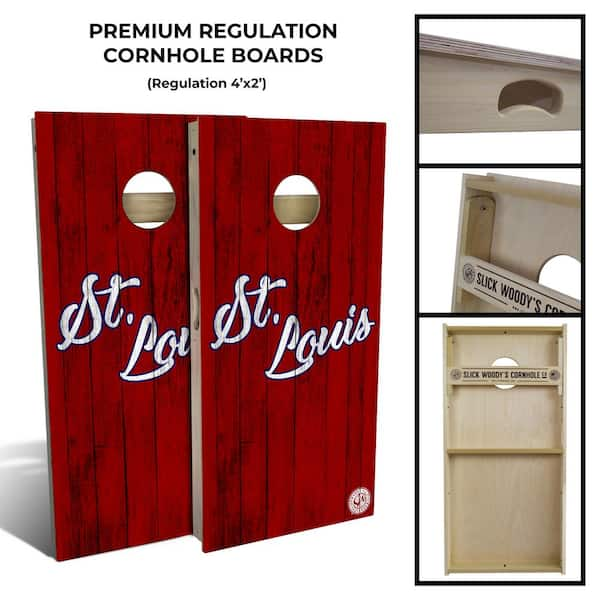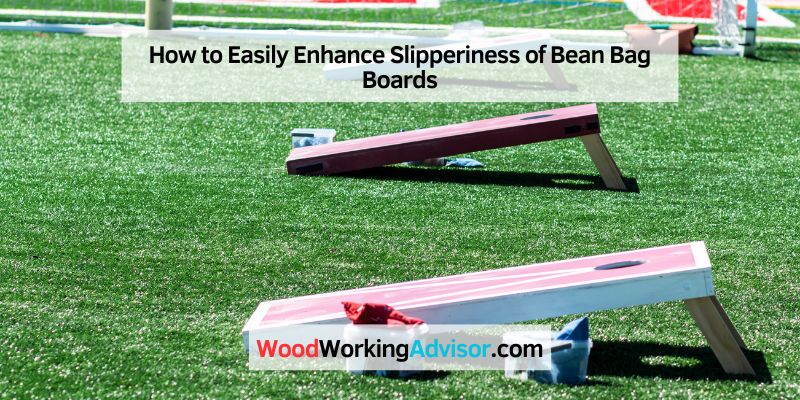To make bean bag boards slippery, apply a coat of polyurethane or silicone spray to the surface. This will create a smooth and slick playing surface.
Introducing the right amount of slipperiness to your bean bag boards is crucial to ensure accurate and enjoyable gameplay. Whether you are a casual player or a serious cornhole enthusiast, having a properly slippery surface is essential. Without it, the bean bags may stick or slide inconsistently, affecting the game’s flow and accuracy.
In the following sections, we will explore different methods for making your bean bag boards slippery and help you choose the best option for your needs.
Understanding Slipperiness
Bean bag boards can be made slippery by using various techniques, such as applying a slick surface coating or using specialized bean bag fillings. These methods enhance the game experience and ensure that the bags slide smoothly across the board for maximum fun.
Factors Affecting Slipperiness
The slipperiness of bean bag boards plays a crucial role in the overall game experience. There are several factors that contribute to the level of slipperiness on the boards. Understanding these factors will enable you to make the necessary adjustments to enhance your gameplay.
Impact On Gameplay
The slipperiness of bean bag boards directly affects the gameplay and the strategies employed by the players. Understanding how it impacts the game is essential in order to make the right adjustments. Here are a few ways slipperiness influences the overall gameplay:
- The speed of the bean bags: A slippery surface allows the bags to glide smoothly, increasing their speed and making it more challenging to control their trajectory. This adds an element of excitement and unpredictability to the game.
- The toss accuracy: A slippery surface requires players to adjust their throwing technique. The bags are more likely to slide off the board, necessitating precise aim and control to score points.
- The strategy: Slipperiness affects the strategy employed by players. A less slippery surface may enable players to strategically aim for specific areas of the board, while a highly slippery surface might require a different approach.
Applying Non-slip Solutions
Now, let’s delve into some practical steps you can take to increase the slipperiness of your bean bag boards. Applying non-slip solutions is an effective way to enhance the gameplay experience. Here are a few options you can consider:
- Silicone Spray: One of the easiest and most common solutions is to use a silicone spray designed specifically for increasing slipperiness. Apply the spray evenly on the surface of the boards and allow it to dry before use.
- Furniture Polish: Another readily available option is to use furniture polish. Apply a thin layer of furniture polish on the boards, making sure to spread it evenly. Polish-containing silicone will provide better slipperiness.
- Wax: Waxing the bean bag boards is a traditional method that can help reduce friction and increase slipperiness. Ensure the boards are clean and dry before applying the wax. Use a cloth to evenly spread a thin layer of wax and polish it gently for a smooth finish.
Maintaining Slipperiness
After applying the non-slip solutions, it’s important to maintain the slipperiness of your bean bag boards. Regular cleaning and reapplication may be necessary depending on the frequency of use and the condition of the boards. Here are some tips to help you maintain slipperiness:
- Cleaning: Regularly clean the boards using a mild detergent and water. Remove any dirt or debris that may have accumulated on the surface. Avoid using abrasive cleaners that could damage the boards.
- Reapplication: Reapply the non-slip solution as needed. Over time, the slipperiness may diminish, especially with frequent use. Monitor the performance of the boards and apply the solution as required to maintain optimal slipperiness.
- Storage: Find a suitable storage space for your bean bag boards to protect them from dust and moisture. Covering them with a dust sheet or storing them in a dry location will help preserve the slipperiness for longer periods.

Credit: www.homedepot.com
Enhancing Slipperiness
To enhance the slipperiness of bean bag boards, follow these simple steps: 1) Apply a layer of top-quality polyurethane coating to the surface; 2) Sprinkle a fine layer of cornstarch or baby powder; 3) Rub the powder into the surface with a cloth; 4) Repeat the process multiple times for optimal results.
Sit back, toss those bags, and feel the smooth glide!
Choosing the Right Bean Bag Board Wax
To enhance the slipperiness of your bean bag boards, choosing the right wax is crucial. Different waxes have different properties, so it’s essential to select one that suits your specific needs. Here are some factors to consider when choosing the right bean bag board wax:
1. Type of Wax: There are various types of waxes available such as traditional paraffin wax, specialty waxes, and synthetic waxes. Each type offers different levels of slipperiness, durability, and weather resistance. Also, consider whether you prefer a natural or synthetic wax.
2. Weather Conditions: If you plan to play outdoors, it’s important to choose a wax that can withstand different weather conditions. Look for a wax that is resistant to heat, cold, moisture, and UV rays to ensure optimal performance.
3. Texture: Some waxes have a smoother texture, while others are more gritty. The texture of the wax can affect how the bean bags slide on the board. Consider your playing style and player preferences when deciding on the wax texture that suits you best.
4. Application Ease: Look for a wax that is easy to apply and doesn’t require extensive preparation. Avoid waxes that require heating or special tools for application, as they can be time-consuming and inconvenient.
Application Techniques
Once you’ve selected the right bean bag board wax, it’s important to apply it properly to ensure optimal slipperiness. Here are some recommended application techniques:
1. Clean the Surface: Before applying the wax, ensure that the bean bag board surface is clean and free from dirt, dust, and debris. Use a damp cloth or mild detergent to clean the boards thoroughly and allow them to dry completely.
2. Apply the Wax Evenly: Using a wax applicator or a clean cloth, apply the wax to the surface of the boards. Start from one end and work your way to the other, ensuring that the wax is spread evenly. Apply a thin coat for a moderate amount of slipperiness or add additional layers for a higher degree of slipperiness.
3. Allow the Wax to Set: After applying the wax, allow it to set for the recommended duration specified by the manufacturer. This will ensure that the wax adheres properly to the surface, providing long-lasting slipperiness.
4. Reapply as Needed: Over time and with repeated use, the wax may wear off. To maintain the slipperiness of your bean bag boards, reapply the wax periodically or whenever you feel it is necessary. Regular reapplication will help to keep your boards in optimal condition for enjoyable gameplay.
By choosing the right bean bag board wax and applying it correctly, you can enhance the slipperiness of your boards, making your gameplay more exciting and challenging. Experiment with different waxes and application techniques to find the perfect combination that suits your playing style and preferences.

Credit: www.homedepot.com
Maintenance And Longevity
To make bean bag boards slippery and maintain their longevity, it’s important to use a high-quality wax or silicone-based lubricant. Regularly clean the boards using a damp cloth and avoid exposing them to extreme temperatures. Keeping the surface smooth and well-maintained will help ensure optimal performance and durability for years to come.
Regular cleaning
Regularly cleaning your bean bag boards is key to ensuring their longevity and maintaining top-notch performance. To keep them slippery and ready for play, use a mild detergent and water to wipe down the surface. This will help remove any built-up dirt, grime, or residue that could affect the board’s slickness. Avoid using harsh chemicals or abrasive materials, as these can damage the finish and hinder the boards’ performance. A gentle cleaning routine will prolong the life of your boards and ensure they remain a reliable playing surface for years to come.
Storage Tips
Proper storage is crucial for maintaining the slippery surface of your bean bag boards. When not in use, store them in a cool, dry place to prevent warping or damage. If possible, consider storing them in a protective storage bag or cover to shield them from dust and moisture. Avoid storing them in direct sunlight or extreme temperatures, as these can cause the materials to deteriorate and compromise the playing surface. By following these storage tips, you can prolong the life of your bean bag boards and ensure they’re always ready for a game.
By incorporating these maintenance practices into your routine, you can keep your bean bag boards in optimal condition for years to come. Regular cleaning and proper storage will help maximize their longevity and ensure they remain slippery and enjoyable for countless games and gatherings.

Credit: www.amazon.com
Frequently Asked Questions For How To Make Bean Bag Boards Slippery
How Do You Seal Bean Bag Boards?
To seal bean bag boards, follow these steps:
1. Start by sanding the surface to ensure it is smooth.
2. Apply a coat of primer and let it dry completely.
3. Then, apply several coats of paint, allowing each coat to dry before applying the next.
4. Once the paint is dry, apply a clear sealant to protect the surface and enhance durability.
5. Let the sealant dry completely before using the bean bag boards.
How Long Do You Have To Wait Between Bean Bag Boards?
You should wait between bean bag boards until both players have tossed all of their bags.
How Do You Make Bean Bag Boards?
To make bean bag boards, first, gather materials like plywood, screws, and paint. Then, cut plywood to the desired size and shape. Next, attach legs to the boards for stability. Finally, sand and paint the boards, adding any designs or decals desired.
How Do You Make Bean Bag Boards Slippery?
To make bean bag boards slippery, you can apply a layer of polyurethane or laminate to the surface. This helps reduce friction and allows the bean bags to slide smoothly. Another option is to use furniture wax or silicone spray for a more temporary solution.
Finally, using a higher-quality fabric for the bean bags themselves can also contribute to better slides.
Conclusion
Ensuring the slipperiness of your bean bag boards is essential for an enjoyable playing experience. By following the tips and techniques provided in this blog post, you can effectively enhance the slipperiness of your boards to elevate your gaming sessions.
Experiment with different methods and find the one that best suits your preference. Elevate your bean bag game today!


